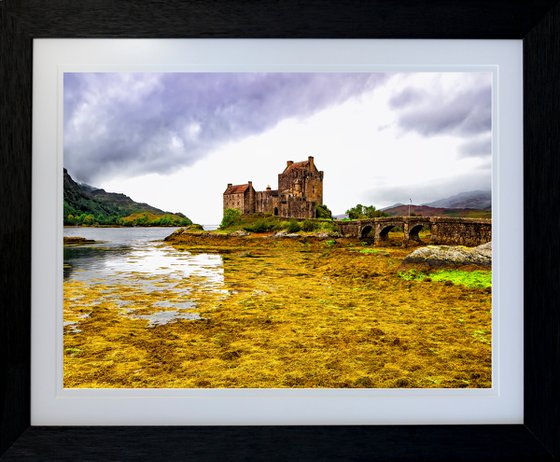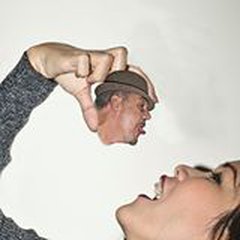Artwork description:
Eilean Donan (Scottish Gaelic: Eilean Donnain) is a small tidal island situated at the confluence of three sea lochs (Loch Duich, Loch Long and Loch Alsh) in the western Highlands of Scotland, about 1 kilometre (5⁄8 mi) from the village of Dornie. It is connected to the mainland by a footbridge that was installed early in the 20th century and is dominated by a picturesque castle that frequently appears in photographs, film and television. The island's original castle was built in the thirteenth century; it became a stronghold of the Clan Mackenzie and their allies, the Clan MacRae. However, in response to the Mackenzies' involvement in the Jacobite rebellions early in the 18th century, government ships destroyed the castle in 1719. The present-day castle is Lieutenant-Colonel John Macrae-Gilstrap's 20th-century reconstruction of the old castle.
Eilean Donan is part of the Kintail National Scenic Area, one of 40 in Scotland. In 2001, the island had a recorded population of just one person, but there were no "usual residents" at the time of the 2011 census.
Eilean Donan, which means simply "island of Donnán", is named after Donnán of Eigg, a Celtic saint who was martyred in 617. Donnán is said to have established a church on the island, though no trace of this remains.
It is possible that an early Christian monastic cell was founded on the island in the 6th or 7th century, and that it was dedicated to Donnán of Eigg, an Irish saint who was martyred on Eigg in April 617. No remains of any Christian buildings survive, though fragments of vitrified stone (stone that has been subjected to very high temperatures) have been discovered, indicating that there was an Iron Age or early medieval fortification on the island.
In the earlier thirteenth century, during the reign of Alexander II (ruled 1214–1249), a large curtain-wall castle (wall of enceinte) was constructed; it enclosed much of the island. At this time, the area around the island was at the boundary of the Norse-Celtic Lordship of the Isles and the Earldom of Ross: Eilean Donan provided a strong defensive position against Norse expeditions. A founding legend has it that the son of a chief of the Mathesons acquired the power to communicate with birds; as a result of this power, and after many adventures overseas, he gained wealth, power, and the respect of Alexander II, who asked him to build the castle to defend his realm.
At a later date, the island became a stronghold of the Mackenzies of Kintail, originally vassals of William I, Earl of Ross. At this early stage, the castle is said to have been garrisoned by Macraes and Maclennans, both clans that were later closely associated with the Mackenzies. Traditional Mackenzie clan histories relate that Earl William sought advantage from the Treaty of Perth of 1266, by which King Magnus VI of Norway ceded the Hebrides to Scotland, and demanded that his kinsman Kenneth Mackenzie return the castle to allow his expansion into the islands. Mackenzie refused, and Earl William led an assault against Eilean Donan that the Mackenzies and their allies repulsed.
The Mackenzie clan histories also claim (with little, if any, supporting contemporary evidence), that Robert the Bruce sheltered at Eilean Donan during the winter of 1306 to 1307; the castle escaped any other involvement in the Wars of Scottish Independence. In 1331 Thomas Randolph, Earl of Moray, sent an officer to Eilean Donan to warn the occupants of his forthcoming visit. In preparation 50 wrongdoers were rounded up and executed, their heads being displayed on the castle walls to Moray's approval. By the middle of the 14th century the Mackenzies are said to have been on the losing side in the ongoing feuding with the Earls of Ross. William III, Earl of Ross granted Kintail to Raghnall Mac Ruaidhrí in 1342. With the assistance of Leod Macgilleandrais, the Earl allegedly apprehended Kenneth Mackenzie, 3rd of Kintail, and had him executed in 1346 at Inverness. Through this period Eilean Donan is said to have been held by Duncan Macaulay for the Mackenzies, against the Earl and his allies.[12] Kenneth's young son Murdo Mackenzie supposedly evaded the Earl's attempts to eliminate him, and on the return of David II from exile Murdo Mackenzie was allegedly confirmed in the lands of Kintail and Eilean Donan by a charter of 1362 (of which, however, no trace survives to the present day). At some point in the earlier 14th century it is thought that the Clan Macrae began to settle in Kintail as a body, having migrated from the Beauly Firth, and there gained the trust of the Mackenzie lairds through possible kinship and an advantageous marriage. The Macraes began to act as Mackenzie's bodyguards, acquiring the soubriquet "Mackenzie's shirt of mail".
Materials used:
Baryta 300gsm Archival paper, Solid Wood frame, Archival Double Mount, anti reflective clear acrylic
Tags:
#scotland #glencoe #kinlochleven #pap of glencoe #glencoe massacre #clan mcdonaldEilean Donan Castle Southside - Kyle of Lochalsh Western Scottish Highlands (2021)
Photograph
by Michael McHugh
£315
- Photograph on Paper
- From a limited edition of 10
- Size: 62.7 x 47 x 2cm (framed) / 45.5 x 30cm (actual image size)
- Framed and ready to hang
- Signed and numbered certificate of authenticity
- Style: Photorealistic
- Subject: Landscapes, sea and sky
Artwork description
Eilean Donan (Scottish Gaelic: Eilean Donnain) is a small tidal island situated at the confluence of three sea lochs (Loch Duich, Loch Long and Loch Alsh) in the western Highlands of Scotland, about 1 kilometre (5⁄8 mi) from the village of Dornie. It is connected to the mainland by a footbridge that was installed early in the 20th century and is dominated by a picturesque castle that frequently appears in photographs, film and television. The island's original castle was built in the thirteenth century; it became a stronghold of the Clan Mackenzie and their allies, the Clan MacRae. However, in response to the Mackenzies' involvement in the Jacobite rebellions early in the 18th century, government ships destroyed the castle in 1719. The present-day castle is Lieutenant-Colonel John Macrae-Gilstrap's 20th-century reconstruction of the old castle.
Eilean Donan is part of the Kintail National Scenic Area, one of 40 in Scotland. In 2001, the island had a recorded population of just one person, but there were no "usual residents" at the time of the 2011 census.
Eilean Donan, which means simply "island of Donnán", is named after Donnán of Eigg, a Celtic saint who was martyred in 617. Donnán is said to have established a church on the island, though no trace of this remains.
It is possible that an early Christian monastic cell was founded on the island in the 6th or 7th century, and that it was dedicated to Donnán of Eigg, an Irish saint who was martyred on Eigg in April 617. No remains of any Christian buildings survive, though fragments of vitrified stone (stone that has been subjected to very high temperatures) have been discovered, indicating that there was an Iron Age or early medieval fortification on the island.
In the earlier thirteenth century, during the reign of Alexander II (ruled 1214–1249), a large curtain-wall castle (wall of enceinte) was constructed; it enclosed much of the island. At this time, the area around the island was at the boundary of the Norse-Celtic Lordship of the Isles and the Earldom of Ross: Eilean Donan provided a strong defensive position against Norse expeditions. A founding legend has it that the son of a chief of the Mathesons acquired the power to communicate with birds; as a result of this power, and after many adventures overseas, he gained wealth, power, and the respect of Alexander II, who asked him to build the castle to defend his realm.
At a later date, the island became a stronghold of the Mackenzies of Kintail, originally vassals of William I, Earl of Ross. At this early stage, the castle is said to have been garrisoned by Macraes and Maclennans, both clans that were later closely associated with the Mackenzies. Traditional Mackenzie clan histories relate that Earl William sought advantage from the Treaty of Perth of 1266, by which King Magnus VI of Norway ceded the Hebrides to Scotland, and demanded that his kinsman Kenneth Mackenzie return the castle to allow his expansion into the islands. Mackenzie refused, and Earl William led an assault against Eilean Donan that the Mackenzies and their allies repulsed.
The Mackenzie clan histories also claim (with little, if any, supporting contemporary evidence), that Robert the Bruce sheltered at Eilean Donan during the winter of 1306 to 1307; the castle escaped any other involvement in the Wars of Scottish Independence. In 1331 Thomas Randolph, Earl of Moray, sent an officer to Eilean Donan to warn the occupants of his forthcoming visit. In preparation 50 wrongdoers were rounded up and executed, their heads being displayed on the castle walls to Moray's approval. By the middle of the 14th century the Mackenzies are said to have been on the losing side in the ongoing feuding with the Earls of Ross. William III, Earl of Ross granted Kintail to Raghnall Mac Ruaidhrí in 1342. With the assistance of Leod Macgilleandrais, the Earl allegedly apprehended Kenneth Mackenzie, 3rd of Kintail, and had him executed in 1346 at Inverness. Through this period Eilean Donan is said to have been held by Duncan Macaulay for the Mackenzies, against the Earl and his allies.[12] Kenneth's young son Murdo Mackenzie supposedly evaded the Earl's attempts to eliminate him, and on the return of David II from exile Murdo Mackenzie was allegedly confirmed in the lands of Kintail and Eilean Donan by a charter of 1362 (of which, however, no trace survives to the present day). At some point in the earlier 14th century it is thought that the Clan Macrae began to settle in Kintail as a body, having migrated from the Beauly Firth, and there gained the trust of the Mackenzie lairds through possible kinship and an advantageous marriage. The Macraes began to act as Mackenzie's bodyguards, acquiring the soubriquet "Mackenzie's shirt of mail".
Materials used:
Baryta 300gsm Archival paper, Solid Wood frame, Archival Double Mount, anti reflective clear acrylic
Tags:
#scotland #glencoe #kinlochleven #pap of glencoe #glencoe massacre #clan mcdonaldReturns and refunds
We want you to love your art! If you are not completely satisfied with your purchase you can return it free within 14 days, no questions asked. Learn more
This artwork is sold by Michael McHugh from United Kingdom




